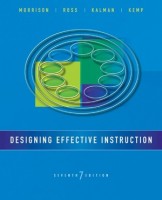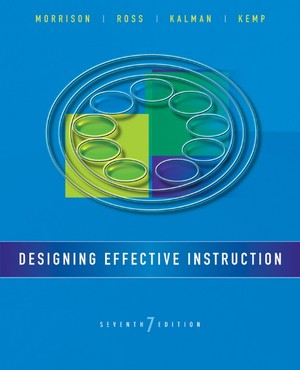 Authors: Gary R. Morrison, Steven M. Ross, Howard K. Kalman and Jerrold E. Kemp
Authors: Gary R. Morrison, Steven M. Ross, Howard K. Kalman and Jerrold E. Kemp
Publisher: Wiley / Jossey-Bass Education
Book Review by: Paiso Jamakar
The authors of this book are all specialists in designing courses that students take at different levels of education, particularly at the college level and beyond. They are called instructional designers and their job is to create effective and efficient instruction methods and systems that teachers and professors can learn from and implement.
This seventh edition of Designing Effective Instruction is based on a book that one of the four authors, Jerry Kemp, wrote more than 40 years ago. The authors point out that this book presents a model of instructional design that, first of all, incorporates many proven-to-be-useful ideas. Secondly, it is based on both behavioral and cognitive approaches.
Third, design decisions presented in this book are based on research, not personal preferences. And fourth, the instructional design model discussed in this volume is flexible and adaptable.
These four features alone, without mentioning any others, elevate the book to a high level of reliability by those involved in learning about and designing instructional courses. Besides that, the authors write that the basics of instructional design offered in this text are applicable in many fields of endeavor, including but not limited to: business, education (from K-12 to college and post-graduate education), the government, healthcare and medicine, and the military establishment.
One of the basic purposes of this book is to provide a solid foundation of knowledge as well as sharing of experience and insight to students in the entire instructional design process and help them develop skills in many settings, including the classroom, distance learning and multimedia.
This book contains a wealth of information on designing effective instruction. Its 16 chapters cover the many areas in the design process from the learning theories to identifying the needs of the learner to instructional objectives to analyzing the task at hand to the messages to be conveyed to strategies to materials to implementation and evaluation, and more. It is very comprehensive in its scope.
This latest edition of the book has been updated with new findings from research in the field as well as recent trends in practice.
The chapters in this book are laid out systematically that makes for easier learning. Among the features are:
- Getting Started – a section that stimulates discussion of a given topic
- Expert’s Edge – Practicing instructional designers share their real-world experience, including successes and failures, perspectives and insight
- The ID Process – a “here’s how it is really done” discussion of each element of the design model
- Applications and Answers – One or two exercises at the end of each chapter for the reader to test their skills and knowledge
- Quality Management – enables a designer to make a quality check of the design project, with key questions and issues to solve instructional problems
- Instructional Design: Decisions and Choices – provides a realistic example of the instructional design process with comments from the designer on the basis of the decisions and choices made at each step of the process.
Nothing can give more credibility to the usefulness of this book than the fact that it has been around since 1971 and improved for more than four decades. This seventh edition has added features that make this book more effective and efficient than ever.
Gary R. Morrison received his doctorate in instructional systems technology from Indiana University in 1977. Currently he is a professor at Old Dominion University where he teaches courses in instructional design. He has written more than 100 papers on topics related to instructional design and computer-based instruction and is the coauthor of the book Integrating Computer Technology into the Classroom. His credits include print projects, multimedia projects, and over 300 hours of instructional video programs.
Steven M. Ross received his doctorate in educational psychology from Pennsylvania State University. Currently he is a senior research scientist and professor at the Center for Research and Reform in Education at Johns Hopkins University. He is the author of six textbooks and over 120 journal articles on educational technology and instructional design, at-risk learners, educational reform, computer-based instruction, and research and evaluation. He is a noted lecturer on school programs and educational evaluation.
Howard K. Kalman received his doctorate in instructional systems technology from Indiana University in 2001. Currently he is an associate professor at Ithaca College where he teaches courses in strategic communication management, learning, and performance improvement. He has authored or coauthored publications on strategic planning, knowledge management, process improvement, and instructional strategies and contributed to the Handbook of Human Performance Technology (second edition).
Jerrold E. Kemp received his doctorate in audiovisual education from Indiana University in 1956. For 30 years, he served as professor of instructional technology and coordinator of instructional development services at San Jose University, California. Jerry first wrote Instructional Design: A Plan for Unit and Course Development in 1971 (Fearon) from which the present book emerged. In addition, he has authored or coauthored three other books dealing with training and technology.







